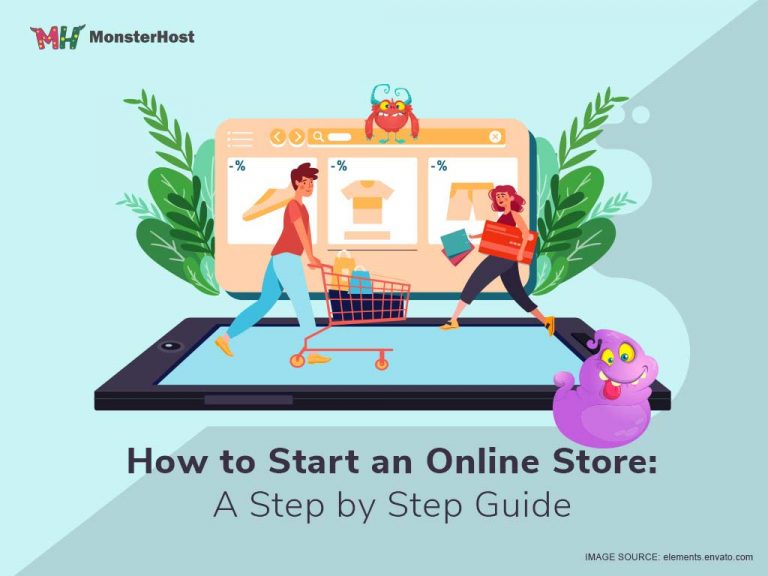There’s never been a better time to create an online store. eCommerce is one of the fastest growing online industries, and brick-and-mortar stores are quickly going the way of the dinosaur. If you’ve always wanted to start an online store so you can take advantage of an opportunity to make huge profits with very little overheads, here’s a step-by-step guide to getting started, even if you’re not a techie: (We even tell you how to get started with web hosting!)
Table of Contents
1. Use a website builder
A website builder is a tool that lets you create a beautiful, professional website in minutes without breaking the bank. When you’re creating your first online store, it’s important that you don’t spend too much money creating your website, because your online store will probably go through several iterations before you find the one that feels right for your brand. A website builder is a great way to quickly get your store up and running, so you can work out all the kinks and find your rhythm.
Using a website builder doesn’t mean you have to skimp on quality. All the websites you create using our website builder have been designed by experts in SEO and web design, and they’re guaranteed to be mobile-friendly!
Our website builder also has tons of eCommerce templates to choose from, so you can take the guesswork out of building your online store.
2. Choose a web hosting plan
Once you have your website, you’ll need somewhere to host it. If you use our website builder, you can host your website right here with us! We offer a range of hosting options that are great for people who want to run an online store. For instance, you can get one of our premium dedicated hosting packages, where you’ll have your own server and you’ll never have to share resources with any other users.
Or if you want the security of dedicated hosting at a fraction of the cost, you can try our VPS hosting package. All our hosting packages are secure, scalable, and priced with your budget in mind. We never overcharge you for our services, and we offer premium hosting packages with 99.9% uptime and 24/7 customer support!
3. Create a domain name
Once you’ve figured out where you’re hosting your website, you’ll want to choose a domain name. The domain name is the part of your website that shows up in your visitors’ browsers when they open your website. (For instance, our domain name is monsterhost.com.)
Your domain name needs to be memorable and evocative of your brand, so don’t rush choosing a name. Spend some time brainstorming your domain name and testing it on your friends, family, and potential customers.
4. Add your products
Take high-quality pictures of your products and add them to your website so that visitors will have a visual representation of what you’re selling. Be sure to choose the smallest file size you can, because the bigger your files, the more slowly your website will load. (JPEG files are great for websites.)
In addition to using a great image, make sure you choose a description that includes keywords. You can get creative with the description if that feels authentic to your brand, but be sure to use a keyword at least once, so that search engines can funnel visitors to your website.
5. Set up your payment system
A good eCommerce website needs a way to collect your visitors’ payment. Add a payment gateway to your website using the eCommerce features on our website builder!
6. Arrange for shipping
You’d be surprised how many people create an eCommerce website and realize too late that they forgot to work out how to actually get the products to their customers. Don’t let this happen to you. Shipping isn’t really on the glamorous side of creating an eCommerce website, so it can be a bit difficult to find information about it, but with a little research, you can figure out which shipping companies are the most reliable.
You can either look this up on Google, or you can buy from a few online stores and take note of which company they used to ship your package. When you’re just starting out, try to stick to the shipping companies used by online stores that are around the same level as you are. These shipping companies are likely to be the ones within your budget.
7. Install an SSL certificate
You can’t collect your customers’ credit card information unless your customers feel safe leaving their information with you. Customers will feel wary leaving even their email address with you if your website looks sketchy.
One easy way to build your customers’ trust in your website is to install an SSL certificate. Websites with SSL certificates protect your visitors’ information and give them visual cues that it’s safe to enter your website. Some browsers will display this with a padlock icon, and some will use a green bar or a check mark. Either way, an SSL certificate is a quick way to build credibility.
8. Advertise your online store
Nobody will buy from your online store if they don’t know you have it. So, advertise it! Use your social media, your friends’ social media, and some fancy keyword-building to get your online store in front of your customers.
The Takeaway
An online store is a great way to make some extra money on the side. And if you play your cards right, you could even make money from it full-time! So, get started as soon as possible by using a website builder to quickly create a professional website. That way, you can start building your online store’s reputation, so you can create a solid brand.






